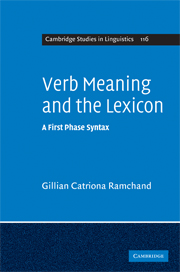4 - Deriving verb classes
Published online by Cambridge University Press: 10 October 2009
Summary
Given the outlines of the system presented so far, we can use the primitives at our disposal to discuss the different natural classes of verb that emerge from this kind of syntactic organization. I wish to emphasize that this chapter is not intended primarily as a detailed investigation of any one set of phenomena. The purpose is to explore the ways in which this system can be used to analyse different possible verb types – the emphasis will be on the flexibilities and constraints on the system itself. In each case I indicate what verb types are possible and how they might be instantiated in English. I describe what the most natural mode of analysis would be for many common verb classes in English that have received treatment in the literature, pointing out where the system forces one to make choices between various analytical options. In all cases, the particular structures proposed here are intended to be starting points for more detailed research. In chapters 5 and 6, I take up the issues of path construction and causative formation respectively in more detail, and attempt to make some more substantive proposals.
In general, by taking seriously the event-structure participanthood of arguments, I aim to show that a somewhat different classification of verb types emerges. In addition, the system I am arguing for will allow flexibility in a verb's syntactic behaviour, within a system of constraints. Importantly, some of the previous principles of mapping between lexical information and syntax assumed in the literature will be abandoned.
- Type
- Chapter
- Information
- Verb Meaning and the LexiconA First Phase Syntax, pp. 63 - 109Publisher: Cambridge University PressPrint publication year: 2008



